How to Fertilize Apple Trees: Essential Tips for a Bountiful Harvest
- February 20, 2024
- 0 comment
Maximize your apple harvest with expert fertilizing tips. Learn when, how, and what to use for healthy trees and abundant fruit. Growing apple trees can be a rewarding experience, offering not only beautiful blossoms but also delicious fruits. However, achieving a bountiful harvest requires more than just planting and watering. Fertilization plays a crucial role in the health and productivity of your apple trees.
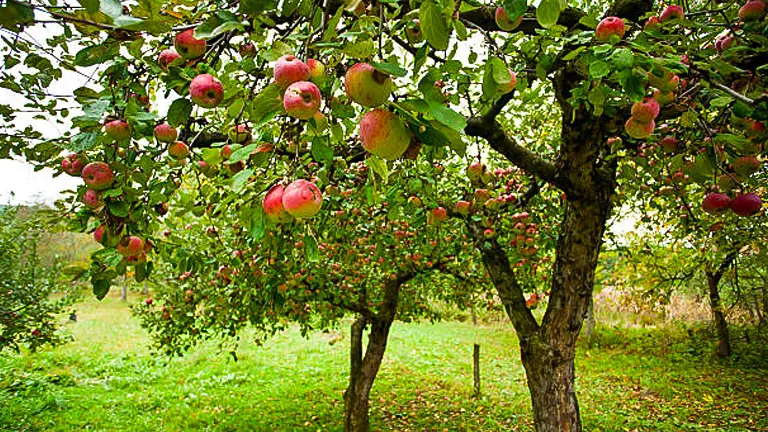
In this guide, we’ll dive into the essential tips for fertilizing apple trees, covering the best practices for timing, methods, and types of fertilizers to ensure your trees are nourished and ready to produce an abundant harvest. Whether you’re a seasoned gardener or a beginner, these insights will help you cultivate healthier trees and more flavorful apples.
Table of Contents
- Understanding Apple Tree Nutrition
- Soil Assessment: The Foundation of Fertilization
- Selecting the Appropriate Fertilizer
- Optimal Fertilization Timing
- Fertilizer Application Techniques
- Optimizing Apple Orchard Layout and Tree Management
- Training and Pruning Techniques
- Pest and Disease Management
- The Importance of Mulching
- Achieving Orchard Success
- Conclusion
- FAQs
Understanding Apple Tree Nutrition
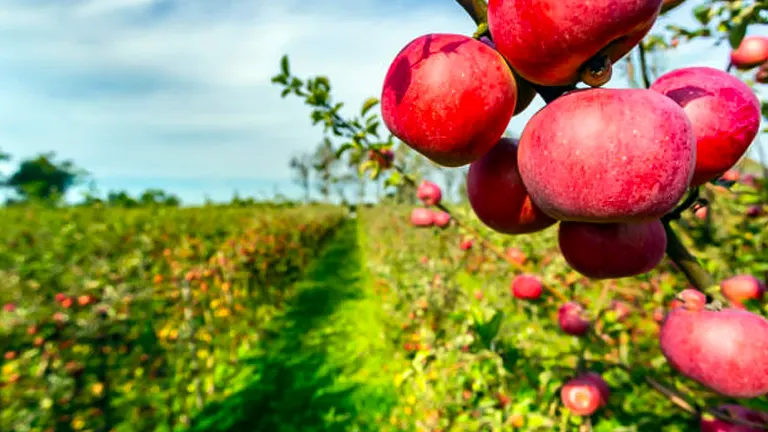
Apple trees demand a balanced nutritional diet to support their growth stages, from leafy development to fruit setting. The cornerstone nutrients—Nitrogen (N), Phosphorus (P), and Potassium (K)—serve distinct roles:
- Nitrogen (N): Nitrogen is pivotal for chlorophyll production, the green pigment responsible for photosynthesis. It promotes vigorous leaf and shoot growth. Apple trees require approximately 30-50 ppm (parts per million) of nitrogen in the soil for optimal growth.
- Phosphorus (P): Essential for energy transfer within the plant, phosphorus affects root development and flowering. It’s crucial during the early growth stages for root establishment and during flowering and fruit set. Optimal soil levels are around 20-30 ppm.
- Potassium (K): Potassium regulates the plant’s water balance and is involved in the activation of enzymes and the production of ATP (adenosine triphosphate), a key energy carrier in cells. It strengthens the tree’s resistance to diseases and environmental stresses. Soil potassium levels should be maintained at 100-150 ppm for healthy growth.
In addition to NPK, apple trees benefit from micronutrients like calcium, which strengthens cell walls, and magnesium, a core component of chlorophyll, vital for photosynthesis. Ensuring these nutrients are in balance is key to avoiding issues such as leaf chlorosis, weak root systems, or poor fruit quality.
Micronutrients
While NPK are the marquee nutrients, apple trees also require micronutrients in smaller quantities, which play critical roles in their physiological processes:
- Calcium (Ca): Integral for cell wall strength and development, calcium is also vital for enzyme activity and starch metabolism. Apple trees thrive in soil with calcium levels of 1000-1500 ppm.
- Magnesium (Mg): As the central element of the chlorophyll molecule, magnesium is indispensable for photosynthesis. It also plays a role in enzyme activation and phosphorus utilization. Soil magnesium levels should be around 100-200 ppm.
- Zinc (Zn): Critical for protein synthesis and growth regulation, zinc deficiency can lead to stunted growth and poor fruit set. Optimal soil zinc levels are 5-10 ppm.
- Iron (Fe): Necessary for chlorophyll synthesis, iron deficiency is often marked by chlorosis or yellowing of the leaves. Soil should have iron levels of 4.5-5.5 ppm for healthy tree growth.
Nutritional Requirements for Apple Trees
| Nutrient | Role in Plant | Optimal Soil Level (ppm) |
|---|---|---|
| Nitrogen (N) | Leaf and shoot growth, chlorophyll production | 30-50 |
| Phosphorus (P) | Root development, energy transfer, flowering | 20-30 |
| Potassium (K) | Water regulation, enzyme activation, disease resistance | 100-150 |
| Calcium (Ca) | Cell wall strength, enzyme activity | 1000-1500 |
| Magnesium (Mg) | Chlorophyll synthesis, enzyme activation | 100-200 |
| Zinc (Zn) | Protein synthesis, growth regulation | 5-10 |
| Iron (Fe) | Chlorophyll synthesis | 4.5-5.5 |
This enhanced nutritional profile underscores the importance of a balanced diet for apple trees, highlighting the interconnectedness of these nutrients in supporting various physiological processes. Regular soil testing and careful management of nutrient levels can help maintain optimal tree health and maximize fruit production, catering to both the tree’s needs and the orchardist’s goals.
Soil Assessment: The Foundation of Fertilization
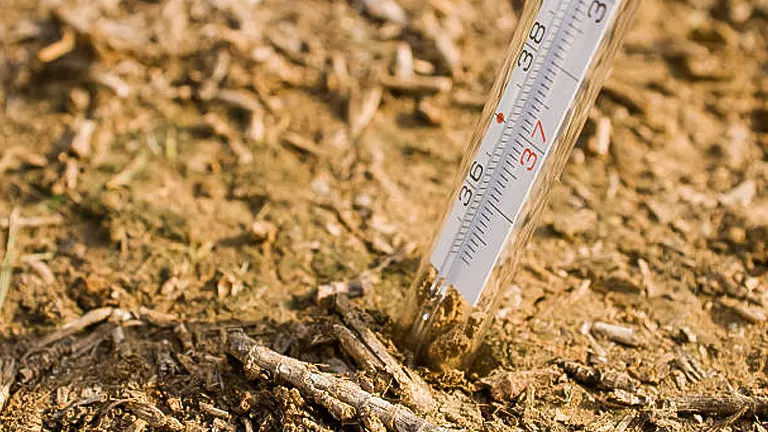
The success of a fertilization plan hinges on a thorough understanding of the orchard’s soil conditions. Conducting a detailed soil assessment is critical for identifying nutrient levels, pH balance, and other key soil characteristics that impact nutrient availability and tree health. This section outlines a clear, actionable process for soil testing.
Simplified Approach to Soil Testing
- Sampling Method: Systematically collect soil samples from multiple locations within your orchard at a depth of 6-8 inches to accurately assess the root zone conditions. For orchards with varied soil types or topography, sample these areas separately to ensure targeted soil management.
- Choosing a Lab for Soil Analysis: Select a laboratory experienced in agricultural soil testing. Provide detailed information about your orchard, such as tree species, age, and any current fertilization practices, to receive recommendations tailored to your specific needs.
- Understanding Soil Test Results: Collaborate with a soil expert or local extension service to interpret the soil test report. Focus on key findings such as nutrient levels and pH, and understand their implications for your fertilization strategy.
Key Components of Soil Analysis
- Nutrient Profile and pH Level: The test should cover essential nutrients (NPK) and pH balance, fundamental for determining the fertilization needs. Apple trees thrive in slightly acidic soil (pH 6.0-7.0), where nutrients are more readily absorbed.
- Tailoring Fertilization Plans: Use the soil analysis to customize your fertilization approach. If the soil is rich in one nutrient but lacking in another, adjust your fertilizer choice accordingly to address these specific needs.
- Long-Term Soil Health: Consider the test’s findings to plan not just for immediate fertilization needs but also for the long-term improvement of soil health. Strategies might include adding organic matter to improve soil structure or adjusting pH levels to optimize nutrient availability.
Utilizing Technology for Precision
- Digital Mapping: Employ digital soil maps for a detailed understanding of soil variability within the orchard. This information can guide more precise fertilization practices.
- Remote Sensing: Use remote sensing tools for insights into soil moisture and organic matter levels. This technology helps predict potential nutrient deficiencies before they affect tree health.
Selecting the Appropriate Fertilizer
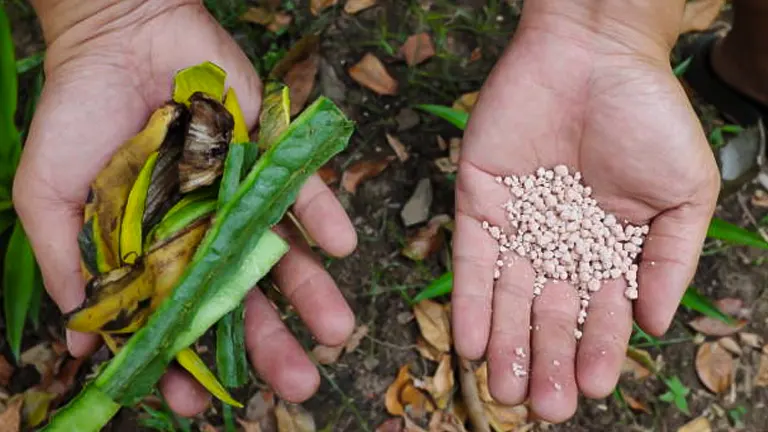
Choosing the right fertilizer is a crucial step that directly impacts the health and productivity of your apple orchard. With a clear understanding of your soil’s nutrient profile from soil tests, you can make informed decisions about the type of fertilizer that will best meet the needs of your trees. Here’s a more detailed look at the options and considerations for selecting the optimal fertilizer.
- Organic Fertilizers: These are derived from natural materials, including plant, animal, and mineral sources. They release nutrients slowly, mirroring the natural nutrient uptake rhythm of plants. Organic fertilizers not only supply essential nutrients but also contribute to the soil’s long-term health by improving its structure, enhancing moisture retention, and fostering a vibrant microbial community. Common examples include compost, manure, bone meal, fish emulsion, and seaweed extracts.
- Synthetic Fertilizers: Manufactured to offer a high concentration of specific nutrients, synthetic fertilizers provide a quick boost to plants. They come in various formulations, including granular for slow-release and liquid for immediate absorption. Precision in application is crucial to prevent the risks of over-fertilization, such as nutrient leaching and environmental pollution.
Choosing between organic and synthetic fertilizers involves considering the immediate needs of your trees against the long-term health of your orchard and soil.
Organic vs. Synthetic Fertilizers
| Aspect | Organic Fertilizers | Synthetic Fertilizers |
|---|---|---|
| Nutrient Release Rate | Slow, aligned with natural growth cycles | Fast, immediate impact |
| Nutrient Concentration | Lower, varied based on source | Higher, precisely formulated |
| Soil Health Impact | Enhances structure, moisture retention, and microbial diversity | Limited benefit to soil structure; potential harm with misuse |
| Environmental Sustainability | Low risk of leaching and pollution; improves soil ecosystem | Higher risk of leaching and pollution; energy-intensive production |
| Application Frequency | More frequent applications required | Less frequent, depends on formulation |
| Long-Term Orchard Health | Builds soil fertility and resilience | Quick nutrient fixes withou |
Making the Right Choice
- Balancing Immediate Needs with Long-Term Health: Evaluate the immediate nutritional needs of your orchard against the desired long-term soil and tree health. For quick nutrient corrections, synthetic fertilizers may be the right choice. However, for ongoing soil health and sustainability, organic fertilizers are preferable.
- Consider Environmental Impact: Organic fertilizers are generally more environmentally friendly, improving soil health without the risk of chemical runoff. If opting for synthetic fertilizers, choose products with a low environmental impact and apply them responsibly.
- Tailoring to Orchard Needs: Some orchards may benefit from a combination of both organic and synthetic fertilizers. For example, you might use organic fertilizers to build soil health and synthetic ones to address specific nutrient deficiencies.
Optimal Fertilization Timing
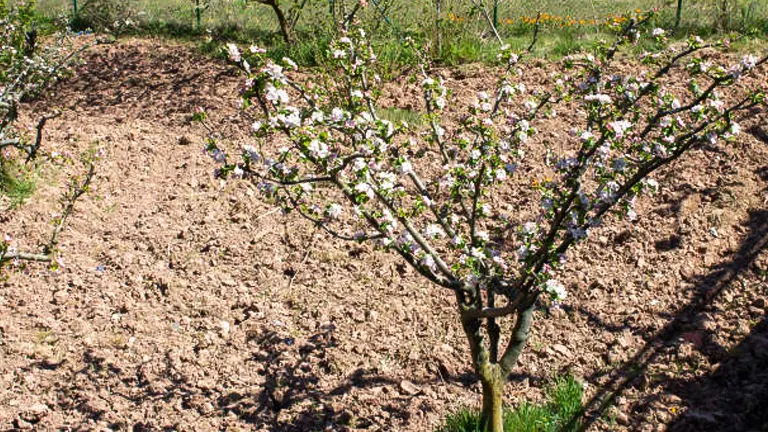
The timing of fertilizer application significantly affects nutrient uptake and tree health. The critical periods for fertilization are:
Detailed Timing Strategies
- Dormant Season (Late Winter to Early Spring): Apply a slow-release fertilizer as the ground thaws but before bud break. This timing helps replenish nutrient reserves depleted over winter, setting the stage for vigorous spring growth. For regions with mild winters, timing may need adjustment to align with local climate conditions.
- Bud Break to Pre-Bloom: This is a critical window for applying a balanced fertilizer to support the rapid growth of leaves and flowers. The goal is to provide a boost in nutrients just as the trees begin active growth, ensuring they have the resources needed for leaf development and successful pollination.
- Post-Bloom to Early Fruit Development: After the petals fall and fruit begins to set, applying fertilizer can support fruit development and growth. This application should be carefully managed to avoid excessive vegetative growth at the expense of fruit quality.
- Mid-Summer (Optional): In some cases, a light application of fertilizer in mid-summer may benefit trees showing signs of nutrient deficiency or to support heavily fruiting trees. However, this should be approached with caution to prevent encouraging late-season growth susceptible to winter damage.
Age-Specific Considerations
- Young Trees (1-3 years): Focus on phosphorus-rich fertilizers to encourage strong root development. Young trees benefit from multiple light applications throughout the growing season rather than fewer, heavier applications. This approach helps avoid nutrient runoff and supports steady growth.
- Mature Trees: For established trees, the emphasis shifts towards balanced N-P-K fertilizers to support both vegetative growth and fruit production. Timing should be adjusted based on the tree’s growth stage, soil nutrient levels, and previous yield outcomes to tailor nutrient support specifically to the tree’s needs.
Additional Insights for Optimal Fertilization
- Soil Temperature and Moisture: Nutrient uptake is influenced by soil temperature and moisture levels. Fertilizers are most effective when the soil is moist (but not waterlogged) and when temperatures are conducive to active root absorption (generally above 50°F/10°C).
- Environmental Considerations: Consider the local ecosystem and weather patterns when planning fertilizer applications. Avoid fertilizing before heavy rains to prevent nutrient runoff into waterways, and consider the use of controlled-release fertilizers to minimize environmental impact.
- Monitoring and Adjustment: Observing the trees’ response to fertilization and adjusting timing and application rates accordingly is key. Leaf color, growth patterns, and fruit development are indicators of the tree’s nutritional status and can guide future fertilization strategies.
Fertilizer Application Techniques
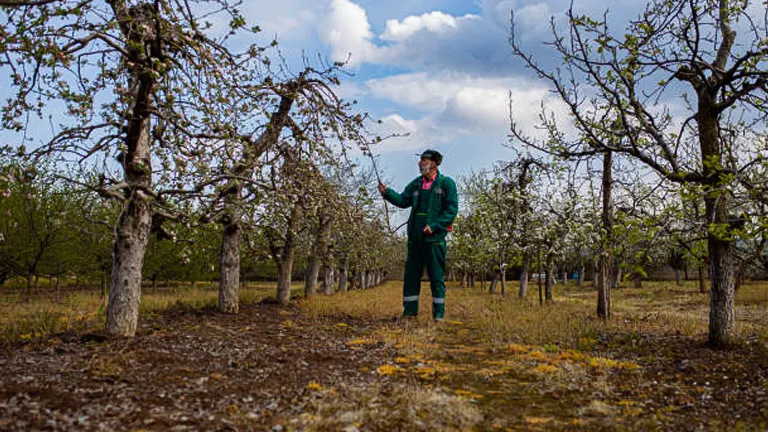
Effective fertilizer application ensures that nutrients reach the tree’s roots without waste or damage:
Precision Dosing Strategies
- Soil Test-Based Formulation: Start with a detailed soil test to determine nutrient deficiencies. Tailor the fertilizer mix to address these specific needs, considering both macro and micronutrient requirements.
- Tree Age and Production Stage: Adjust fertilizer quantities based on the tree’s development stage. Younger trees with developing root systems have different nutritional needs compared to mature, fruit-bearing trees. Factor in the tree’s health and previous year’s yield as indicators of nutrient demand.
- Variable Rate Application (VRA): Utilize VRA technology to apply fertilizers at variable rates within the orchard, based on soil fertility maps. This technique ensures that each area receives an optimal nutrient dose, reducing waste and environmental impact.
Enhanced Distribution Methods
- Drip Line Precision: While applying around the drip line is standard, further refine this method by creating a slight trench along the drip line for granular fertilizers. This can help in directing nutrients closer to the roots and improving absorption.
- Foliar Feeding: Consider foliar applications for micronutrients or quick corrections. This method involves spraying a diluted fertilizer solution directly onto the leaves, where nutrients can be rapidly absorbed. Foliar feeding is particularly effective for addressing micronutrient deficiencies.
- Root Zone Injection: For deep nutrient delivery, especially in sandy soils where leaching is a concern, root zone injection can be a valuable technique. This method involves injecting liquid fertilizer directly into the soil near the root zone, ensuring nutrients are placed where they are most needed.
Integrated Watering Techniques
- Irrigation Integration: For orchards with irrigation systems, fertigation—the combination of fertilization and irrigation—can be an efficient way to apply water-soluble fertilizers. This method ensures even distribution and reduces nutrient runoff.
- Post-Application Watering: If fertigation is not an option, ensure thorough watering after applying granular or liquid fertilizers. This helps dissolve and carry the nutrients into the soil, enhancing root uptake. However, avoid over-watering, which can lead to nutrient leaching.
Monitoring and Adjusting
- Soil Moisture and Temperature: Monitor soil moisture and temperature conditions to optimize application timing. Fertilizer is best applied when the soil is moist (but not saturated) and when temperatures are moderate to facilitate active root absorption.
- Post-Application Assessment: Conduct follow-up soil tests and observe tree response after fertilization to assess the effectiveness of the application strategy. Adjust future applications based on these observations and any changes in tree health or soil conditions.
Optimizing Apple Orchard Layout and Tree Management
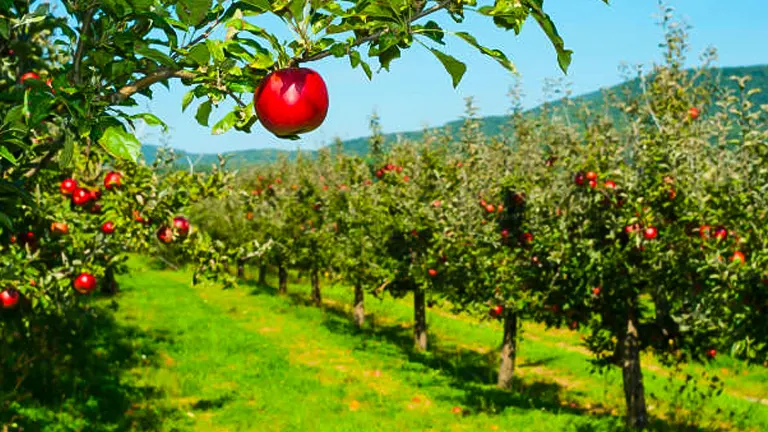
The success of an apple orchard is significantly influenced by how trees are spaced and managed. Correct plant-to-plant and row-to-row distances, especially in medium and high-density orchards, are crucial for maximizing sunlight exposure, air circulation, and ease of maintenance. Additionally, adopting appropriate training and pruning techniques is essential for enhancing fruit quality and yield.
Plant-to-Plant and Row-to-Row Distancing
Medium-Density Orchards: These orchards typically feature spacing that balances efficient land use with accessibility for maintenance and harvesting.
- Plant-to-Plant Distance: 12 to 15 feet (3.6 to 4.6 meters) between trees.
- Row-to-Row Distance: 18 to 20 feet (5.5 to 6 meters) between rows.
This arrangement allows for adequate sunlight and air circulation, minimizing disease pressure and promoting healthy growth.
High-Density Orchards: Characterized by closer spacing to increase tree count per acre, high-density orchards require precise management to ensure tree health and productivity.
- Plant-to-Plant Distance: 3 to 4 feet (0.9 to 1.2 meters) between trees.
- Row-to-Row Distance: 10 to 12 feet (3 to 3.7 meters) between rows.
Such spacing is often used in conjunction with dwarf rootstocks and trellising systems to support the trees and manage their growth.
Training and Pruning Techniques
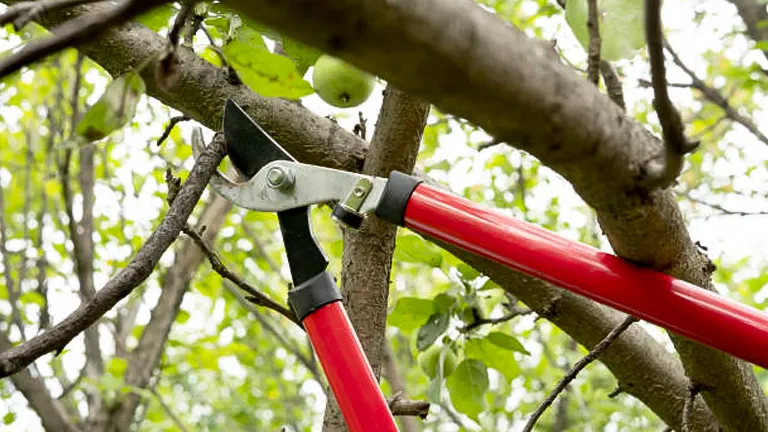
Training Techniques: Training starts from the tree’s planting and is crucial for shaping its structure for optimal growth and fruit production.
- Central Leader System: Common for medium-density orchards, this system trains the tree to have one main vertical trunk (the central leader) with horizontal branches. It’s ideal for varieties that require more space and facilitates good air and light penetration.
- Vertical Axis System: Preferred for high-density orchards, this method involves training the tree around a central leader with tightly controlled branch angles. It maximizes space efficiency and enhances sunlight exposure to lower branches.
Pruning Techniques: Pruning is performed to remove unnecessary branches, open up the tree canopy, and improve fruit quality and yield.
- Winter Pruning: Conducted during dormancy, winter pruning focuses on shaping the tree and thinning out dense areas to improve light penetration and air flow.
- Summer Pruning: Targets the removal of upright growth that can shade the tree and reduce fruit quality. It’s also used to manage tree size and enhance fruit exposure to sunlight.
Integrated Pest Management (IPM): Combining plant spacing and pruning with IPM strategies can significantly reduce pest and disease pressures. Properly spaced and pruned trees are less susceptible to many common orchard pests and diseases due to improved air circulation and sunlight penetration.
Pest and Disease Management
A key aspect of maintaining a healthy orchard and ensuring the effectiveness of your fertilization efforts is the management of pests and diseases. Apple trees can be susceptible to a variety of pests and diseases, which can affect fruit quality and yield. Integrated Pest Management (IPM) strategies can help minimize these risks:
- Regular Monitoring: Keep a close eye on your trees for signs of pest activity or disease. Early detection is crucial for effective management.
- Cultural Controls: Implement practices such as proper pruning, sanitation (removing fallen fruit and leaves), and choosing disease-resistant varieties to reduce the risk of pest and disease outbreaks.
- Biological Controls: Encourage or introduce natural predators of common pests into your orchard as a sustainable control method.
- Chemical Controls: Use pesticides judiciously, only when necessary, and according to label instructions. Opt for environmentally friendly options whenever possible.
By adopting a holistic approach to pest and disease management, you can protect your apple trees and ensure that your fertilization efforts lead to the desired outcomes.
The Importance of Mulching
Mulching provides multiple benefits for apple trees, particularly in terms of moisture retention, temperature regulation, and weed control. A layer of organic mulch, such as wood chips or straw, applied around the base of the trees can:
- Conserve Moisture: Mulch helps retain soil moisture, reducing the need for frequent watering and ensuring that nutrients remain available to the tree roots.
- Regulate Soil Temperature: Mulch acts as an insulator, keeping the soil cooler in the summer and warmer in the winter, which can promote healthier root development.
- Suppress Weeds: By covering the soil, mulch reduces weed germination and growth, minimizing competition for nutrients and water.
Mulching also contributes to soil health by gradually decomposing and adding organic matter, further enhancing the effectiveness of your fertilization program.
Achieving Orchard Success
The journey to a bountiful apple harvest is a complex but rewarding one, involving careful attention to the nutritional needs of your trees, soil health, pest and disease management, and cultural practices like mulching and pruning. Each element of orchard care plays a crucial role in ensuring the health and productivity of your apple trees.
- Continuous Learning: Stay informed about the latest in apple orchard management techniques and innovations. The field is always evolving, and new methods can offer improved outcomes.
- Patience and Observation: The most successful orchardists are those who closely observe their trees and respond to their needs. Patience is key, as the benefits of your efforts may take time to fully manifest.
By following the guidelines outlined in this article and committing to ongoing care and management, you can achieve a thriving orchard that provides abundant, high-quality apple harvests for years to come.
Conclusion
Achieving a bountiful harvest from your apple orchard is a complex, yet deeply rewarding endeavor that requires knowledge, dedication, and a willingness to adapt and evolve with the landscape and its ecosystem. By integrating the essential practices discussed, from soil health and nutrition management to sustainable and eco-friendly approaches, you’re laying the groundwork for a productive, resilient, and environmentally conscious orchard.
FAQs
- What is the best time of year to fertilize apple trees?
The optimal times are early spring before bud break and again in late spring or early summer after bloom. Avoid fertilizing in late summer or fall to prevent stimulating new growth that could be damaged by winter cold. - How do I determine the right amount of fertilizer for my apple trees?
The amount of fertilizer needed depends on the tree’s size, age, soil nutrient levels, and the type of fertilizer used. Conduct a soil test to determine nutrient deficiencies and follow the recommended rates based on the test results and product instructions. - Can I use organic fertilizers for my apple trees, and what are the benefits?
Yes, organic fertilizers such as compost, manure, and bone meal are excellent for apple trees. They release nutrients slowly, improve soil structure, and support beneficial microbial activity, contributing to long-term soil health. - What nutrients are most important for apple tree health and fruit production?
Nitrogen (N), Phosphorus (P), and Potassium (K) are crucial for apple trees. Nitrogen promotes leaf and shoot growth, phosphorus supports root development and fruit set, and potassium aids in water regulation and disease resistance. - How does the soil’s pH level affect apple tree fertilization?
Soil pH affects nutrient availability. Apple trees prefer slightly acidic soil (pH 6.0-7.0). If the soil test indicates a pH outside this range, you may need to adjust it using lime (to increase pH) or sulfur (to decrease pH) for optimal nutrient uptake. - Should I fertilize young apple trees differently than mature ones?
Yes, young trees benefit from fertilizers higher in phosphorus to encourage strong root development, while mature fruit-bearing trees require a balanced N-P-K fertilizer to support both growth and fruit production. - How can over-fertilization of apple trees be avoided?
Over-fertilization can be avoided by following soil test recommendations, measuring fertilizer accurately, and applying it evenly. It’s also important to observe the tree’s response to fertilization and adjust future applications accordingly. - Is it necessary to water apple trees after fertilizing, and why?
Yes, watering after applying fertilizer helps dissolve the nutrients and carry them into the soil, making them accessible to the tree’s roots. It ensures the fertilizer is utilized effectively and reduces the risk of nutrient runoff.
Mastering the art of fertilizing apple trees is essential for any orchard’s success. By following the simple yet effective tips outlined in this guide, you can look forward to enjoying a vibrant orchard and a plentiful harvest of delicious apples. Remember, the secret to healthy trees and generous yields lies in understanding their nutritional needs and meeting them thoughtfully. Here’s to your fruitful endeavors!

Benjamin Brooks
Forestry AuthorGreetings! I'm Benjamin Brooks, and my journey over the past 15 years has revolved around the fascinating realms of content creation, expertise in snow clearing, and the intricate world of lumberjacking and landscaping. What began as a simple curiosity about the natural world and heavy machinery has evolved into a passionate profession where my love for crafting words intertwines seamlessly with my lumberjacking and garden skills.













Leave your comment